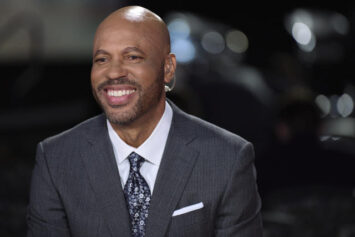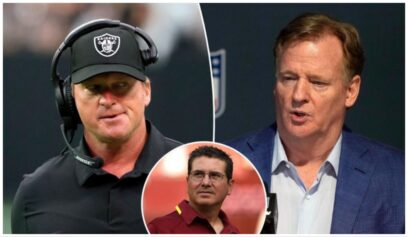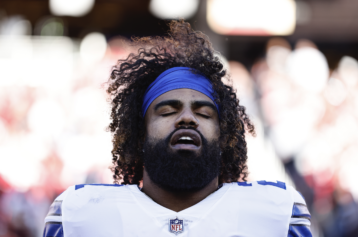Dallas Cowboys running back Ezekiel Elliott now finds himself in the crosshairs of a bitter dispute with the NFL regarding the arbitrary six-game suspension Roger Goodell handed down as a result of the league’s investigation into his alleged acts of domestic violence against a former girlfriend.
Despite the Columbus, Ohio Police Department’s refusal to pursue criminal charges against Elliott, and the recommendation of an NFL investigator who interviewed his accuser to not suspend him, Goodell dropped the hammer anyway.
While filing an appeal and waiting to see if the league is going to shorten or do away with the suspension, Elliott and the NFLPA took matters into their own hands with the additional step of suing the NFL.
Adam Schefter on Twitter
Harold Henderson, the appeals officer in the Ezekiel Elliott hearing, is under pressure to have a decision by Monday, per source.
The petition, filed by famed antitrust attorney Jeffrey Kessler, claims that the league’s investigation and suspension of Elliott was “one of the most fundamentally unfair arbitral processes conceivable.”
The petition also states that there was a “conspiracy” to “hide critical information” and accuses NFL special counsel Lisa Friel of withholding from Commissioner Goodell the word of co-lead investigator Kia Roberts, who the suit says concluded that the accuser wasnt credible and that discipline wasnt warranted.
As a result of the NFLPA lawsuit, the transcripts from the NFL’s investigation into Elliott became available for the first time, along with the transcripts from his arbitration hearing that took place starting on August 29th.
At some point during the arbitration hearing, Elliott had to answer questions under oath from NFL lawyer Daniel Nash. During his questioning, Nash specifically asked Elliott if he liked to do drink and do drugs, and in both cases, Elliott confirmed that he did while he was a student at Ohio State.
Ohio State RB Ezekiel Elliott 2015 Highlights
Ohio State RB Ezekiel Elliott 2015 Highlights Junior 6’1 225 lbs 2015 Stats: 289 ATT 1821 Yards 6.3 YPC 23 Touchdowns Follow me on Twitter! https://twitter.com/ScottTakade Check out my backup channel: https://www.youtube.com/channel/UCT48sLMEjRc40Ts-cm70E3w Intro & out song: https://www.youtube.com/watch?v=6k1FRzJn5VI (All rights go to the Ohio State University, ESPN, xosdigitalsports, Ohio State Athletics, the Big Ten Network, Universal Music Group, the NCAA & it’s broadcasters.
Zeke never specified what drugs he used, but his accuser claims that she’d seen him use marijuana and cocaine previously.
And now the character assassination begins.
Most major publications ran stories yesterday under some derivation of the following headline – “Ezekiel Elliott testifies under oath that he liked to do drugs at Ohio State.”
While many people were quick to cast aspersions on the man, it’s no secret that Ohio State has had its fair share of issues with athletes using drugs.
When elite wide receiver prospect James Robinson was on his recruiting visit in Columbus in late January, he Tweeted, “OSU Players Do So Much Drugs.”
12up on Twitter
An OSU recruit, ladies and gents.
The irony is that Robinson was later issued a citation for marijuana possession while on campus during the visit.
But the problem of drug use extends way beyond star athletes on most campuses across America.
For many college students in general, illicit drugs are as prevalent on their back-to-school supply lists as pencils and notebooks.
According to the University of Michigan’s Monitoring Our Future study, “Illicit drug use has been rising gradually among American college students since 2006…Daily marijuana use is now at the highest rate among college students in more than three decades. Half (51 percent) of all full-time college students today have used an illicit drug at some time in their lives; roughly four in 10 (39 percent) have used one or more such drugs in just the 12 months preceding the survey.”
And weed is just the tip of the iceberg. Let’s not pretend that alcohol and binge-drinking, an accepted part of campus life and a badge of honor to students out on their own for the first time as they cross the bridge into adulthood, isn’t as vicious and destructive as any hardcore drug.
Carson’s Story- A Young Man’s Life and Death
Meet Carson Starkey, learn who he was, how he lived, how he died and how his death continues to change countless lives. Aware Awake Alive promotes safety education about the signs and dangers of alcohol poisoning. Visit us at awareawakealive.org for more on our organization.
The use of psychostimulants such as Adderall and Ritalin has nearly doubled since 2008, and college students have just as much access to Ecstasy and other hallucinogens, along with narcotics such as cocaine, heroin, Vicodin and OxyContin as they do a few tailgate beers, if they know where to find them.
Star players like Elliott may be the face of their respective programs, and people are shocked to learn that they used drugs in college. But where’s the outrage when we remove sports from the equation and look at the rates of excessive drinking and social drug use campus-wide?
Prep school graduates accused of hiring students as dealers in drug ring
Two former students of Haverford School, a prestigious prep school outside Philadelphia, are accused of masterminding an elaborate drug ring catering to affluent students. CBS News’ Vinita Nair reports.
According to the NCAA Student-Athlete Substance Use Study of 2014, Division III athletes had higher usage rates of social drugs than their Division I counterparts. And if you really want to examine an epidemic on the D-I level, look no further than lacrosse, a sport historically played by students from the upper economic strata.
“Examined across sport, mens lacrosse student-athletes reported the highest or near-highest use of many substances including alcohol, cigarettes, spit tobacco, marijuana, synthetic marijuana and cocaine,” the report says. “Approximately 11% of mens lacrosse players indicated that they have used cocaine in the last 12 months. Among women, lacrosse student-athletes reported high usage rates for alcohol, amphetamines, cigarettes, and marijuana. Mens lacrosse players indicated the highest ADHD medication use, including 20% who reported using without a prescription.”
Hearing that Ezekiel Elliott admitted to using drugs and partying like a rock star in college should not surprise you, considering how widespread drug and alcohol abuse are on college campuses.
If you want to get outraged and use his admission as some sort of proof of his lack of moral fiber and character, you need to take a step back. Because the face of drug use, drinking and partying on campus does not belong to the elite Black athletes on television every week.
That face belongs to your average college kid.



